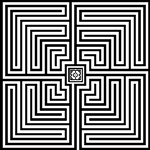
A typical Roman labyrinth design of the simple meander type, laid in the early fourth century CE, at Harpham, England.
© 2004-2024 The Labyrinth Society & Veriditas. All Rights Reserved.
Lorem ipsum dolor sit amet, consectetur adipiscing elit. Ut elit tellus, luctus nec ullamcorper mattis, pulvinar dapibus leo.